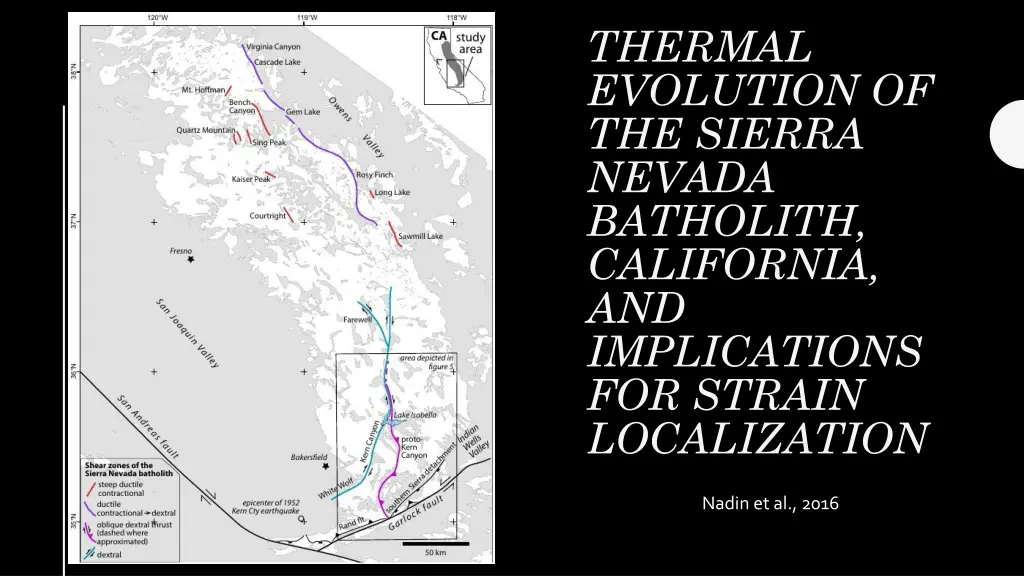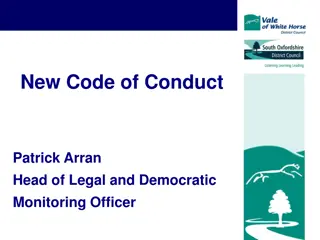
Thermal Evolution of Sierra Nevada Batholith
Explore the thermal evolution of the Sierra Nevada Batholith in California, tracking batholithic cooling and strain localization through U-Pb zircon and 40Ar/39Ar dating. This study delves into the regional thermal state during shear zone formation, presenting new data on deformation ages. Understand the pluton crystallization ages, closure temperatures, and shear zone age distributions to reveal the complex history of this geological formation.
Uploaded on | 1 Views
Download Presentation

Please find below an Image/Link to download the presentation.
The content on the website is provided AS IS for your information and personal use only. It may not be sold, licensed, or shared on other websites without obtaining consent from the author. If you encounter any issues during the download, it is possible that the publisher has removed the file from their server.
You are allowed to download the files provided on this website for personal or commercial use, subject to the condition that they are used lawfully. All files are the property of their respective owners.
The content on the website is provided AS IS for your information and personal use only. It may not be sold, licensed, or shared on other websites without obtaining consent from the author.
E N D
Presentation Transcript
THERMAL EVOLUTION OF THE SIERRA NEVADA BATHOLITH, CALIFORNIA, AND IMPLICATIONS FOR STRAIN LOCALIZATION Nadin et al., 2016
Motivation Summarize all published U-Pb zircon, 40Ar/39Ar hornblende and biotite ages to create age distribution maps which track batholithic cooling from crystallization through the transition to brittle conditions Examine regional thermal state of the SNB during formation of the major shear zones outline on the figure on the title slide. Present new data to constrain deformation ages of the proto-Kern Canyon and Kern Canyon faults (southern SN)
Pluton crystallization ages Contains plutonic material as old as ca. 250 Ma, but primarily high flux magmatism of Cretaceous age U-Pb zircon geochronology (900 C) used to constrain the timing of crystallization on this map General younging to the east Superimposed on here are the shear zones that drive this study They are all Cretaceous structures, and coincide with emplacement of the largest vol. of igneous material (115 83 Ma)
Age data mapping Ar hornblende Closure temp of 525 C Indicates transition of batholith from ductile to brittle Note how shear zones seem to play a part in spatial age distribution
Age data mapping Ar biotite Closure temp of 300 C Batholith acting completely as brittle crust at this point
Shear zone age distribution Contractional structures Contractional to dextral
Location map of new 40Ar/39Ar data These data suggest moderate cooling (350C 165C) from 82-70 Ma Followed by very slow cooling to <150C after 70 Ma The 70 Ma cooling of these samples correlates to a different (younger) cooling history in this southern portion than in the rest of the SNB <17Ma
Farallon plate convergence This is the driver for cooling and deformation of the SNB SNB is in continuous compression from 120 85 Ma At 85 Ma the plate motion transitions from compressional to transpressional This coincides with the major change in the deformational regime, recorded in the shear zones
Discussions Contractional deformation (100-90 Ma) is recorded in short shear zones along the axial zone of the central SNB. The transition to transpressional deformation (90- 80 Ma) is recorded in shear zones along the crest that exist at the boundary between some of the oldest and youngest intrusives These boundaries may have served to localize the shear during this transition as the plate kinematics changed Furthermore, the observations on the proto-Kern Canyon fault and the Kern Canyon fault serve to solidify this interpretation, as the Kern Canyon fault is a dextral fault that overprints the older proto fault
Questions, comments, concerns?






















